Case Study: Organizational Behaviour and Project Management Leadership
VerifiedAdded on 2022/10/12
|14
|2617
|496
Case Study
AI Summary
This case study analyzes the organizational behaviour of Westfarmers Limited, focusing on leadership styles and project management methodologies to enhance productivity. It explores the application of democratic leadership, emphasizing employee involvement in decision-making, and discusses influencing factors, tools like ProofHub and LiquidPlanner, and techniques such as Agile and Waterfall methodologies. The study examines communication factors, the five motivational powers (legitimate, informational, persuasive, ingratiating, and reward), and the use of self-managed teams within agile projects. It justifies the recommended approaches, highlighting customer satisfaction and adaptability, and addresses challenges like irresponsible team members, meeting deadlines, and scope creep, offering solutions to improve project outcomes and organizational effectiveness. The conclusion underscores the importance of incorporating proposed techniques to address project management challenges and enhance overall productivity.
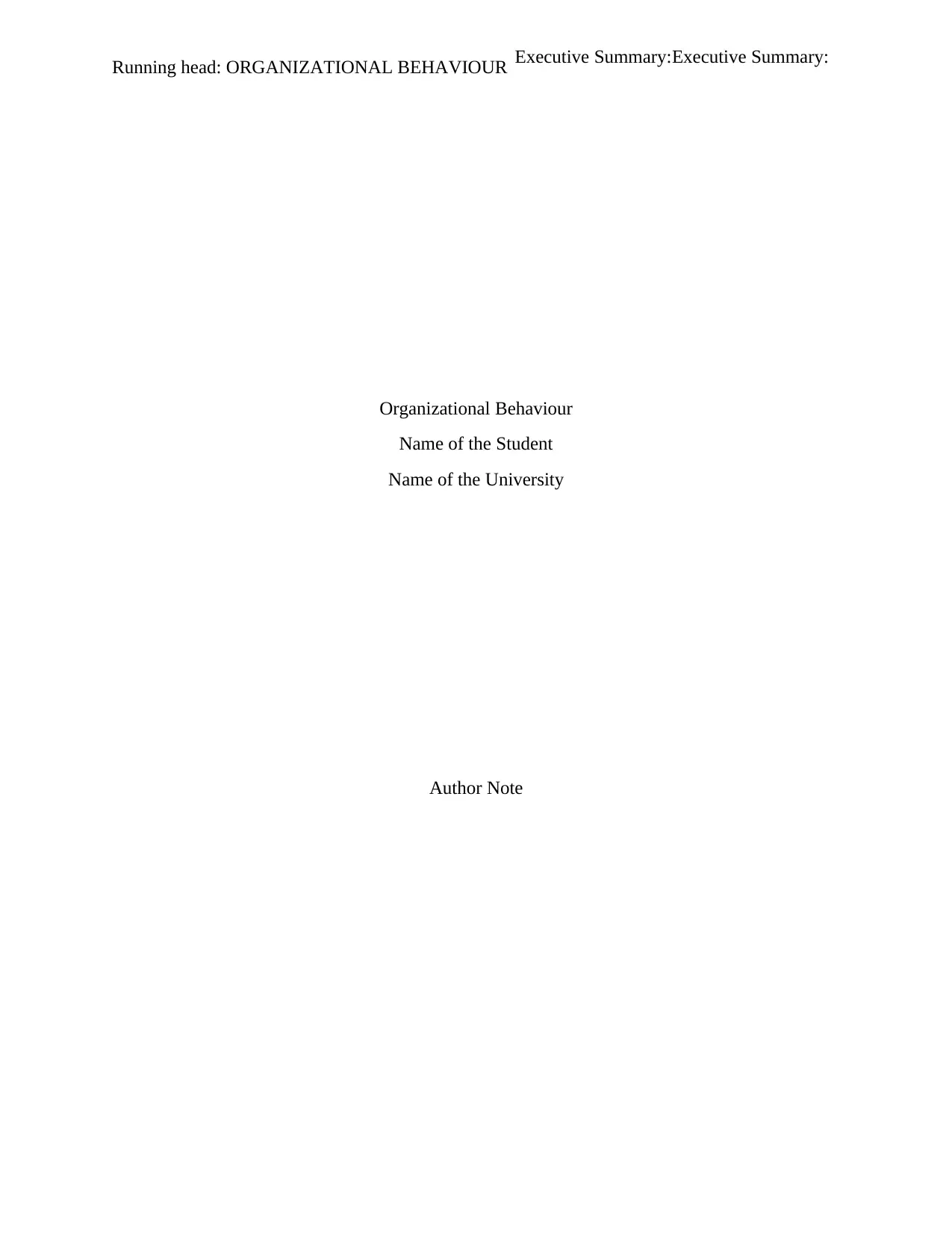
Executive Summary:Executive Summary:
Running head: ORGANIZATIONAL BEHAVIOUR
Organizational Behaviour
Name of the Student
Name of the University
Author Note
Running head: ORGANIZATIONAL BEHAVIOUR
Organizational Behaviour
Name of the Student
Name of the University
Author Note
Paraphrase This Document
Need a fresh take? Get an instant paraphrase of this document with our AI Paraphraser
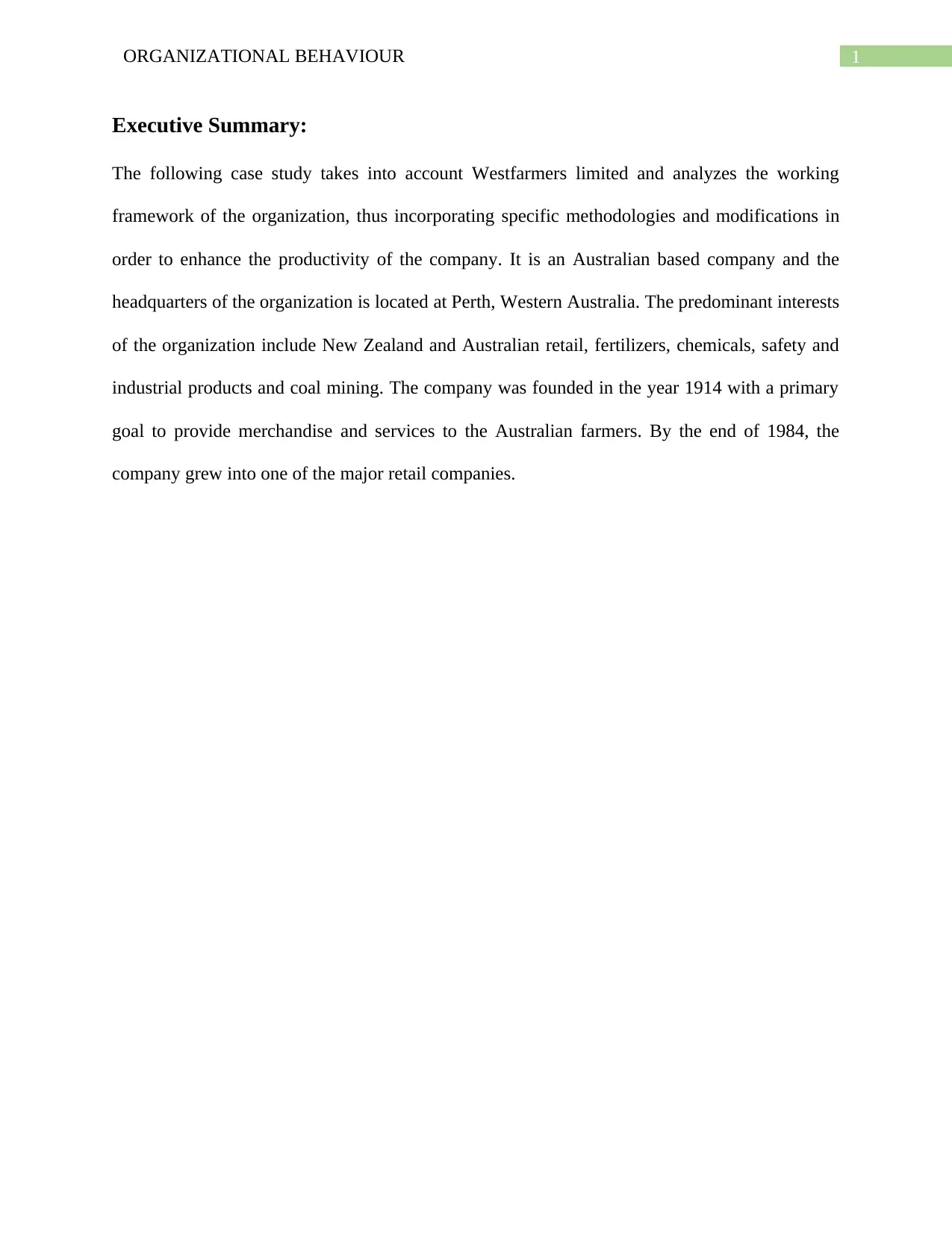
1ORGANIZATIONAL BEHAVIOUR
Executive Summary:
The following case study takes into account Westfarmers limited and analyzes the working
framework of the organization, thus incorporating specific methodologies and modifications in
order to enhance the productivity of the company. It is an Australian based company and the
headquarters of the organization is located at Perth, Western Australia. The predominant interests
of the organization include New Zealand and Australian retail, fertilizers, chemicals, safety and
industrial products and coal mining. The company was founded in the year 1914 with a primary
goal to provide merchandise and services to the Australian farmers. By the end of 1984, the
company grew into one of the major retail companies.
Executive Summary:
The following case study takes into account Westfarmers limited and analyzes the working
framework of the organization, thus incorporating specific methodologies and modifications in
order to enhance the productivity of the company. It is an Australian based company and the
headquarters of the organization is located at Perth, Western Australia. The predominant interests
of the organization include New Zealand and Australian retail, fertilizers, chemicals, safety and
industrial products and coal mining. The company was founded in the year 1914 with a primary
goal to provide merchandise and services to the Australian farmers. By the end of 1984, the
company grew into one of the major retail companies.
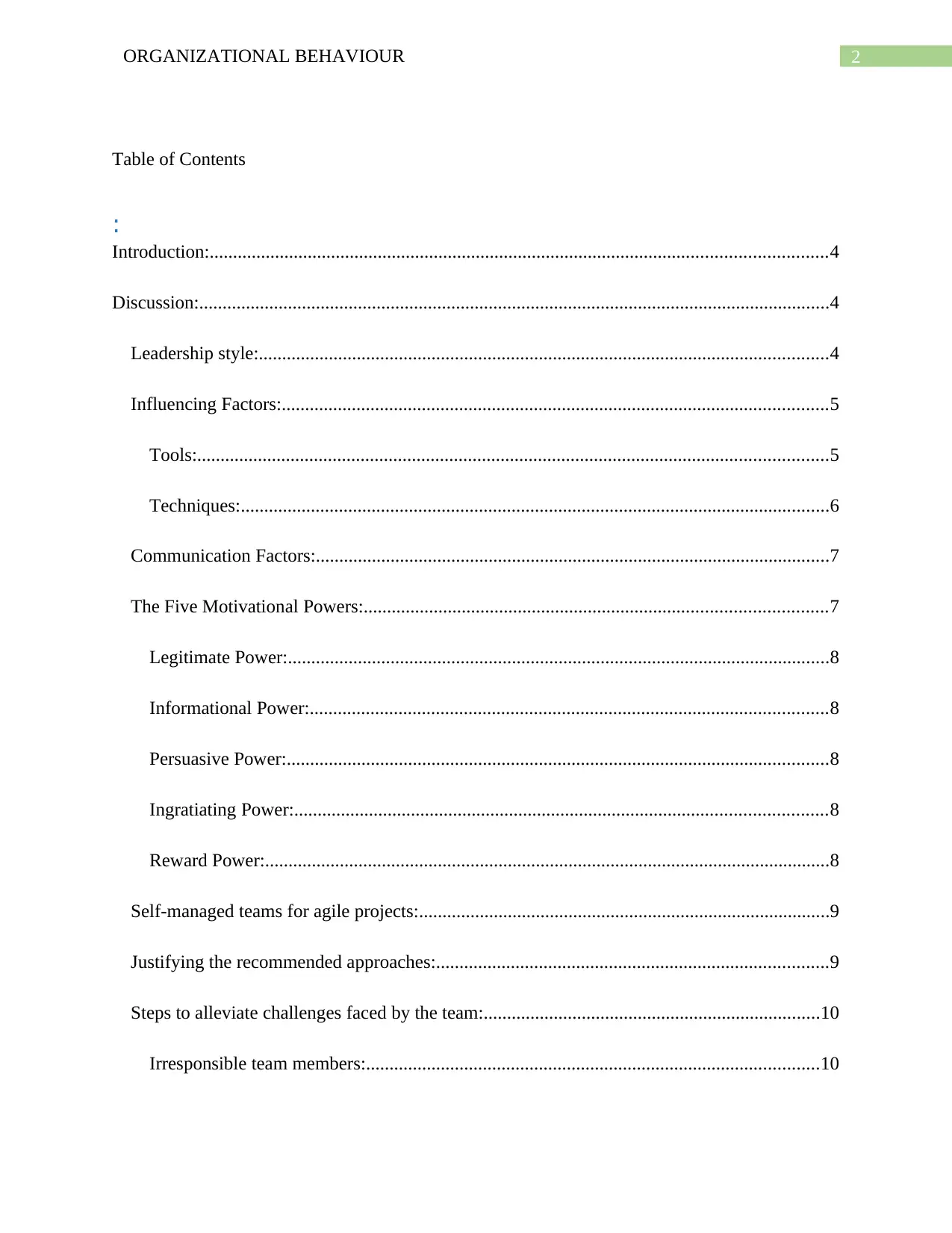
2ORGANIZATIONAL BEHAVIOUR
Table of Contents
:
Introduction:....................................................................................................................................4
Discussion:.......................................................................................................................................4
Leadership style:..........................................................................................................................4
Influencing Factors:.....................................................................................................................5
Tools:.......................................................................................................................................5
Techniques:..............................................................................................................................6
Communication Factors:..............................................................................................................7
The Five Motivational Powers:...................................................................................................7
Legitimate Power:....................................................................................................................8
Informational Power:...............................................................................................................8
Persuasive Power:....................................................................................................................8
Ingratiating Power:..................................................................................................................8
Reward Power:.........................................................................................................................8
Self-managed teams for agile projects:........................................................................................9
Justifying the recommended approaches:....................................................................................9
Steps to alleviate challenges faced by the team:........................................................................10
Irresponsible team members:.................................................................................................10
Table of Contents
:
Introduction:....................................................................................................................................4
Discussion:.......................................................................................................................................4
Leadership style:..........................................................................................................................4
Influencing Factors:.....................................................................................................................5
Tools:.......................................................................................................................................5
Techniques:..............................................................................................................................6
Communication Factors:..............................................................................................................7
The Five Motivational Powers:...................................................................................................7
Legitimate Power:....................................................................................................................8
Informational Power:...............................................................................................................8
Persuasive Power:....................................................................................................................8
Ingratiating Power:..................................................................................................................8
Reward Power:.........................................................................................................................8
Self-managed teams for agile projects:........................................................................................9
Justifying the recommended approaches:....................................................................................9
Steps to alleviate challenges faced by the team:........................................................................10
Irresponsible team members:.................................................................................................10
⊘ This is a preview!⊘
Do you want full access?
Subscribe today to unlock all pages.

Trusted by 1+ million students worldwide
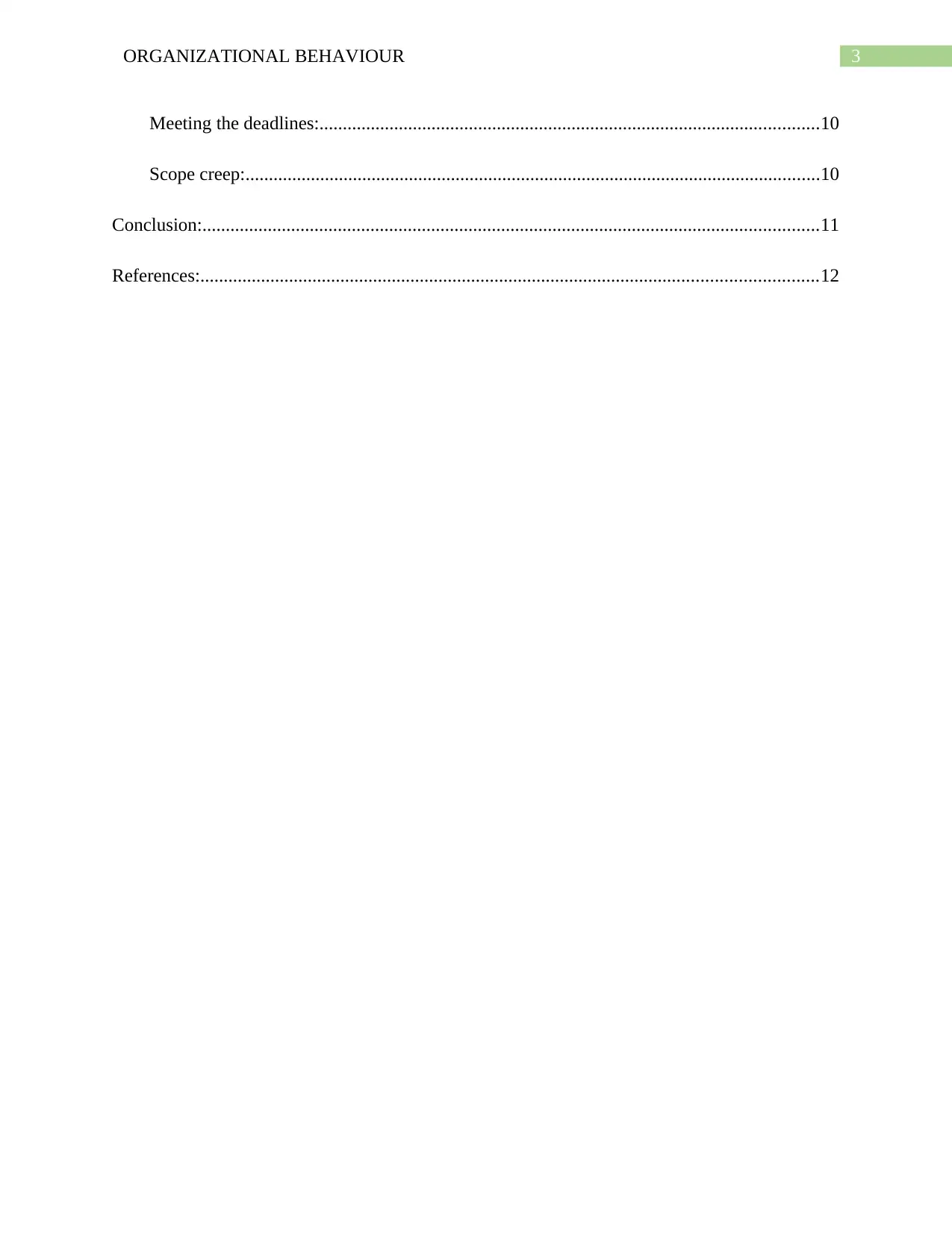
3ORGANIZATIONAL BEHAVIOUR
Meeting the deadlines:...........................................................................................................10
Scope creep:...........................................................................................................................10
Conclusion:....................................................................................................................................11
References:....................................................................................................................................12
Meeting the deadlines:...........................................................................................................10
Scope creep:...........................................................................................................................10
Conclusion:....................................................................................................................................11
References:....................................................................................................................................12
Paraphrase This Document
Need a fresh take? Get an instant paraphrase of this document with our AI Paraphraser
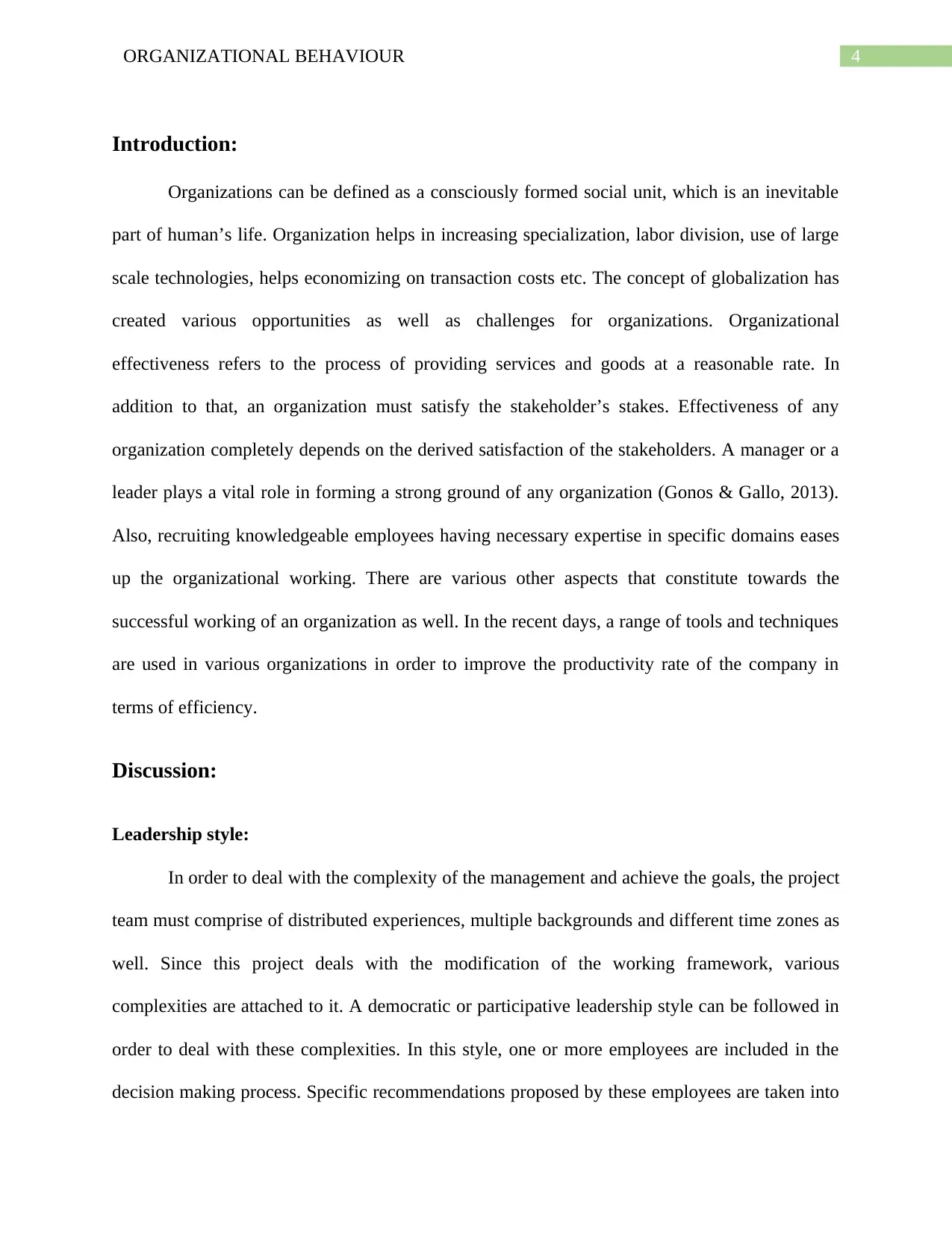
4ORGANIZATIONAL BEHAVIOUR
Introduction:
Organizations can be defined as a consciously formed social unit, which is an inevitable
part of human’s life. Organization helps in increasing specialization, labor division, use of large
scale technologies, helps economizing on transaction costs etc. The concept of globalization has
created various opportunities as well as challenges for organizations. Organizational
effectiveness refers to the process of providing services and goods at a reasonable rate. In
addition to that, an organization must satisfy the stakeholder’s stakes. Effectiveness of any
organization completely depends on the derived satisfaction of the stakeholders. A manager or a
leader plays a vital role in forming a strong ground of any organization (Gonos & Gallo, 2013).
Also, recruiting knowledgeable employees having necessary expertise in specific domains eases
up the organizational working. There are various other aspects that constitute towards the
successful working of an organization as well. In the recent days, a range of tools and techniques
are used in various organizations in order to improve the productivity rate of the company in
terms of efficiency.
Discussion:
Leadership style:
In order to deal with the complexity of the management and achieve the goals, the project
team must comprise of distributed experiences, multiple backgrounds and different time zones as
well. Since this project deals with the modification of the working framework, various
complexities are attached to it. A democratic or participative leadership style can be followed in
order to deal with these complexities. In this style, one or more employees are included in the
decision making process. Specific recommendations proposed by these employees are taken into
Introduction:
Organizations can be defined as a consciously formed social unit, which is an inevitable
part of human’s life. Organization helps in increasing specialization, labor division, use of large
scale technologies, helps economizing on transaction costs etc. The concept of globalization has
created various opportunities as well as challenges for organizations. Organizational
effectiveness refers to the process of providing services and goods at a reasonable rate. In
addition to that, an organization must satisfy the stakeholder’s stakes. Effectiveness of any
organization completely depends on the derived satisfaction of the stakeholders. A manager or a
leader plays a vital role in forming a strong ground of any organization (Gonos & Gallo, 2013).
Also, recruiting knowledgeable employees having necessary expertise in specific domains eases
up the organizational working. There are various other aspects that constitute towards the
successful working of an organization as well. In the recent days, a range of tools and techniques
are used in various organizations in order to improve the productivity rate of the company in
terms of efficiency.
Discussion:
Leadership style:
In order to deal with the complexity of the management and achieve the goals, the project
team must comprise of distributed experiences, multiple backgrounds and different time zones as
well. Since this project deals with the modification of the working framework, various
complexities are attached to it. A democratic or participative leadership style can be followed in
order to deal with these complexities. In this style, one or more employees are included in the
decision making process. Specific recommendations proposed by these employees are taken into
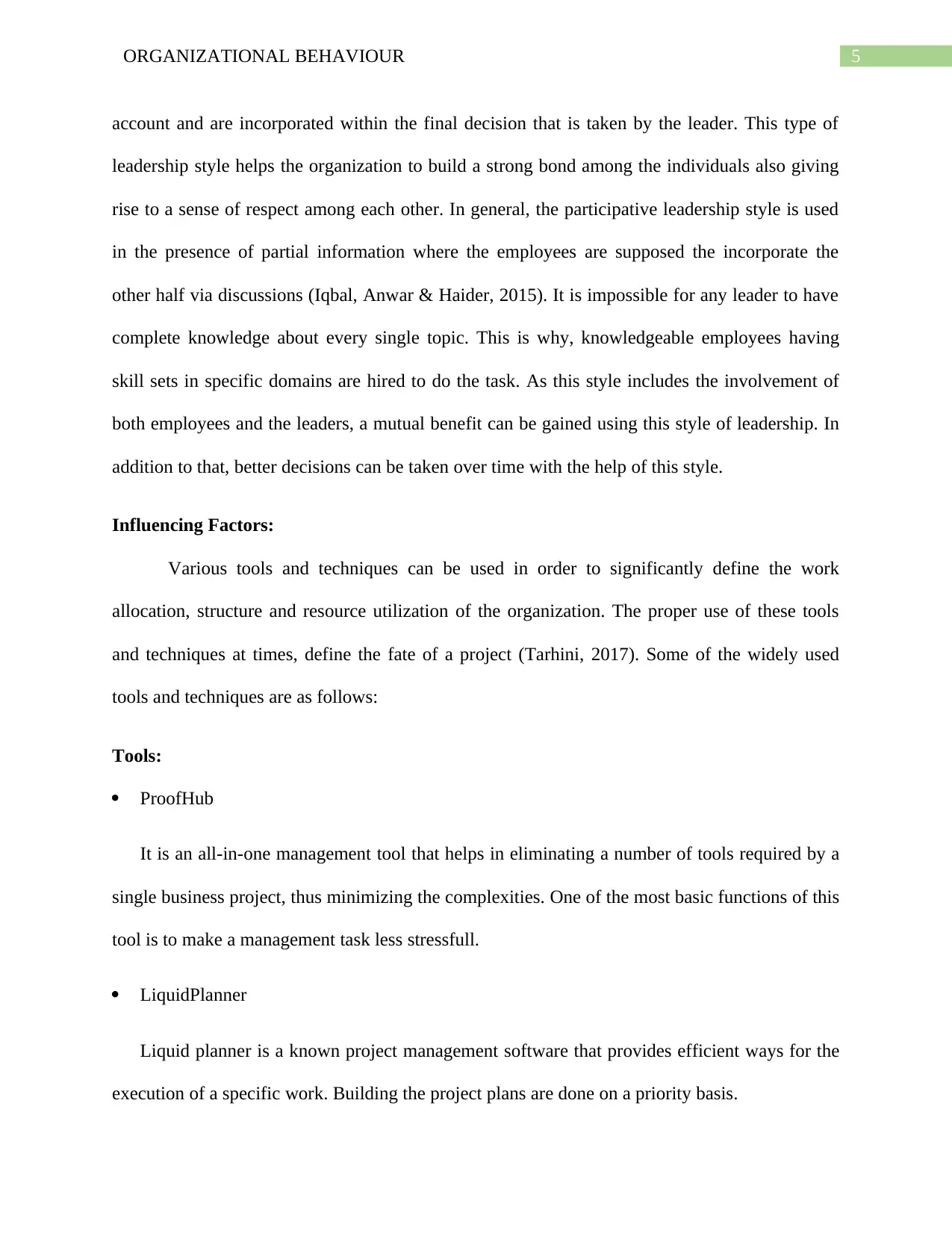
5ORGANIZATIONAL BEHAVIOUR
account and are incorporated within the final decision that is taken by the leader. This type of
leadership style helps the organization to build a strong bond among the individuals also giving
rise to a sense of respect among each other. In general, the participative leadership style is used
in the presence of partial information where the employees are supposed the incorporate the
other half via discussions (Iqbal, Anwar & Haider, 2015). It is impossible for any leader to have
complete knowledge about every single topic. This is why, knowledgeable employees having
skill sets in specific domains are hired to do the task. As this style includes the involvement of
both employees and the leaders, a mutual benefit can be gained using this style of leadership. In
addition to that, better decisions can be taken over time with the help of this style.
Influencing Factors:
Various tools and techniques can be used in order to significantly define the work
allocation, structure and resource utilization of the organization. The proper use of these tools
and techniques at times, define the fate of a project (Tarhini, 2017). Some of the widely used
tools and techniques are as follows:
Tools:
ProofHub
It is an all-in-one management tool that helps in eliminating a number of tools required by a
single business project, thus minimizing the complexities. One of the most basic functions of this
tool is to make a management task less stressfull.
LiquidPlanner
Liquid planner is a known project management software that provides efficient ways for the
execution of a specific work. Building the project plans are done on a priority basis.
account and are incorporated within the final decision that is taken by the leader. This type of
leadership style helps the organization to build a strong bond among the individuals also giving
rise to a sense of respect among each other. In general, the participative leadership style is used
in the presence of partial information where the employees are supposed the incorporate the
other half via discussions (Iqbal, Anwar & Haider, 2015). It is impossible for any leader to have
complete knowledge about every single topic. This is why, knowledgeable employees having
skill sets in specific domains are hired to do the task. As this style includes the involvement of
both employees and the leaders, a mutual benefit can be gained using this style of leadership. In
addition to that, better decisions can be taken over time with the help of this style.
Influencing Factors:
Various tools and techniques can be used in order to significantly define the work
allocation, structure and resource utilization of the organization. The proper use of these tools
and techniques at times, define the fate of a project (Tarhini, 2017). Some of the widely used
tools and techniques are as follows:
Tools:
ProofHub
It is an all-in-one management tool that helps in eliminating a number of tools required by a
single business project, thus minimizing the complexities. One of the most basic functions of this
tool is to make a management task less stressfull.
LiquidPlanner
Liquid planner is a known project management software that provides efficient ways for the
execution of a specific work. Building the project plans are done on a priority basis.
⊘ This is a preview!⊘
Do you want full access?
Subscribe today to unlock all pages.

Trusted by 1+ million students worldwide
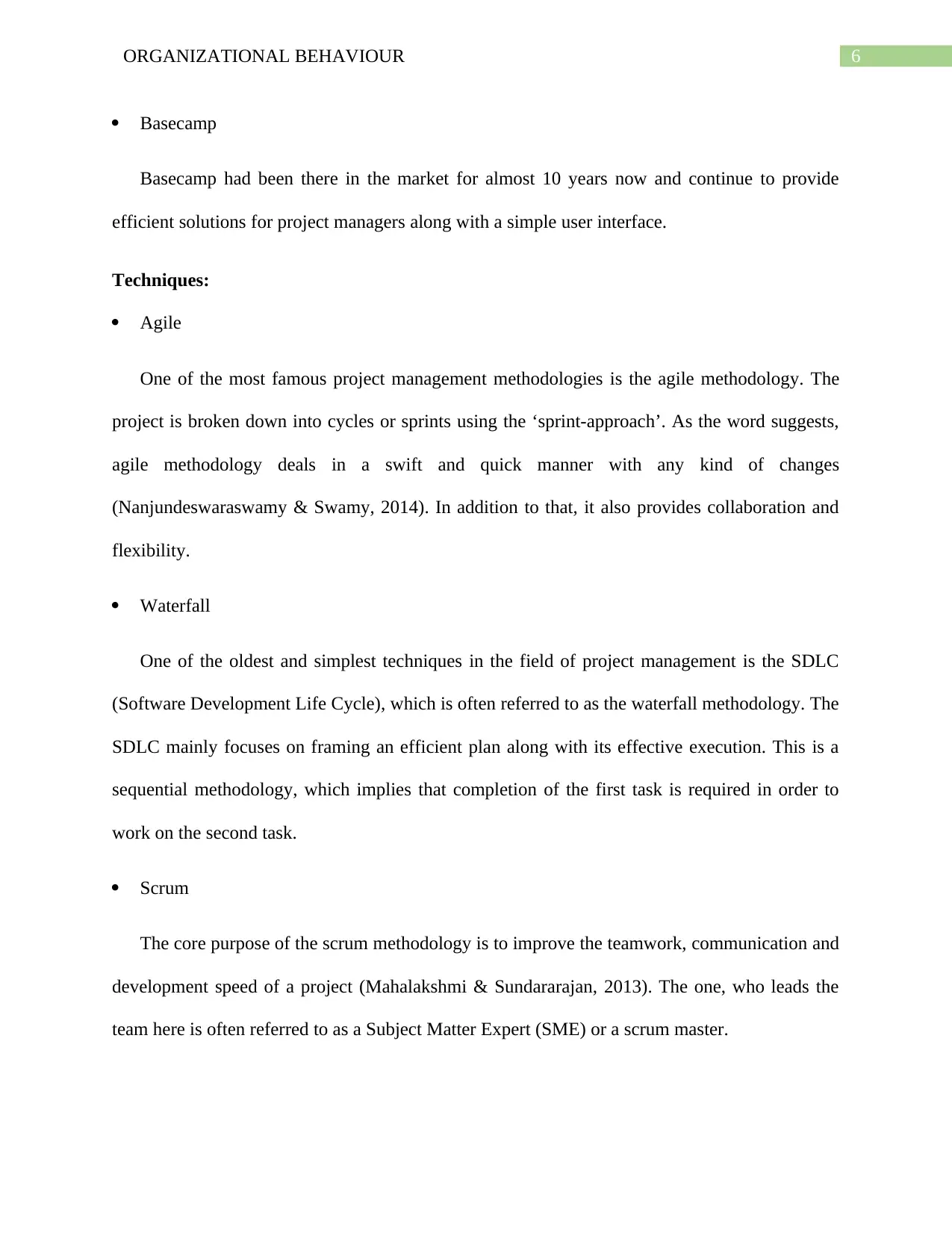
6ORGANIZATIONAL BEHAVIOUR
Basecamp
Basecamp had been there in the market for almost 10 years now and continue to provide
efficient solutions for project managers along with a simple user interface.
Techniques:
Agile
One of the most famous project management methodologies is the agile methodology. The
project is broken down into cycles or sprints using the ‘sprint-approach’. As the word suggests,
agile methodology deals in a swift and quick manner with any kind of changes
(Nanjundeswaraswamy & Swamy, 2014). In addition to that, it also provides collaboration and
flexibility.
Waterfall
One of the oldest and simplest techniques in the field of project management is the SDLC
(Software Development Life Cycle), which is often referred to as the waterfall methodology. The
SDLC mainly focuses on framing an efficient plan along with its effective execution. This is a
sequential methodology, which implies that completion of the first task is required in order to
work on the second task.
Scrum
The core purpose of the scrum methodology is to improve the teamwork, communication and
development speed of a project (Mahalakshmi & Sundararajan, 2013). The one, who leads the
team here is often referred to as a Subject Matter Expert (SME) or a scrum master.
Basecamp
Basecamp had been there in the market for almost 10 years now and continue to provide
efficient solutions for project managers along with a simple user interface.
Techniques:
Agile
One of the most famous project management methodologies is the agile methodology. The
project is broken down into cycles or sprints using the ‘sprint-approach’. As the word suggests,
agile methodology deals in a swift and quick manner with any kind of changes
(Nanjundeswaraswamy & Swamy, 2014). In addition to that, it also provides collaboration and
flexibility.
Waterfall
One of the oldest and simplest techniques in the field of project management is the SDLC
(Software Development Life Cycle), which is often referred to as the waterfall methodology. The
SDLC mainly focuses on framing an efficient plan along with its effective execution. This is a
sequential methodology, which implies that completion of the first task is required in order to
work on the second task.
Scrum
The core purpose of the scrum methodology is to improve the teamwork, communication and
development speed of a project (Mahalakshmi & Sundararajan, 2013). The one, who leads the
team here is often referred to as a Subject Matter Expert (SME) or a scrum master.
Paraphrase This Document
Need a fresh take? Get an instant paraphrase of this document with our AI Paraphraser
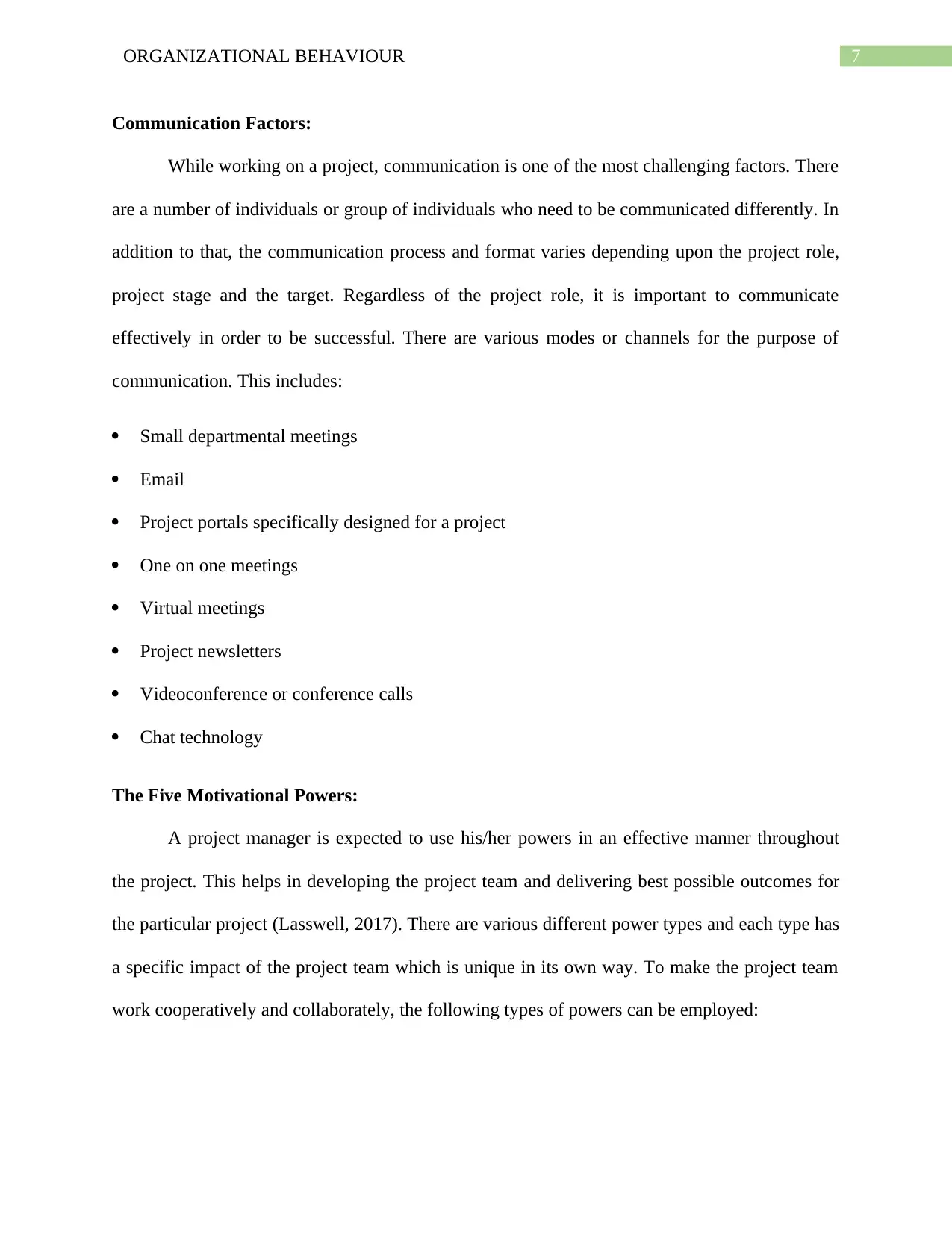
7ORGANIZATIONAL BEHAVIOUR
Communication Factors:
While working on a project, communication is one of the most challenging factors. There
are a number of individuals or group of individuals who need to be communicated differently. In
addition to that, the communication process and format varies depending upon the project role,
project stage and the target. Regardless of the project role, it is important to communicate
effectively in order to be successful. There are various modes or channels for the purpose of
communication. This includes:
Small departmental meetings
Email
Project portals specifically designed for a project
One on one meetings
Virtual meetings
Project newsletters
Videoconference or conference calls
Chat technology
The Five Motivational Powers:
A project manager is expected to use his/her powers in an effective manner throughout
the project. This helps in developing the project team and delivering best possible outcomes for
the particular project (Lasswell, 2017). There are various different power types and each type has
a specific impact of the project team which is unique in its own way. To make the project team
work cooperatively and collaborately, the following types of powers can be employed:
Communication Factors:
While working on a project, communication is one of the most challenging factors. There
are a number of individuals or group of individuals who need to be communicated differently. In
addition to that, the communication process and format varies depending upon the project role,
project stage and the target. Regardless of the project role, it is important to communicate
effectively in order to be successful. There are various modes or channels for the purpose of
communication. This includes:
Small departmental meetings
Project portals specifically designed for a project
One on one meetings
Virtual meetings
Project newsletters
Videoconference or conference calls
Chat technology
The Five Motivational Powers:
A project manager is expected to use his/her powers in an effective manner throughout
the project. This helps in developing the project team and delivering best possible outcomes for
the particular project (Lasswell, 2017). There are various different power types and each type has
a specific impact of the project team which is unique in its own way. To make the project team
work cooperatively and collaborately, the following types of powers can be employed:
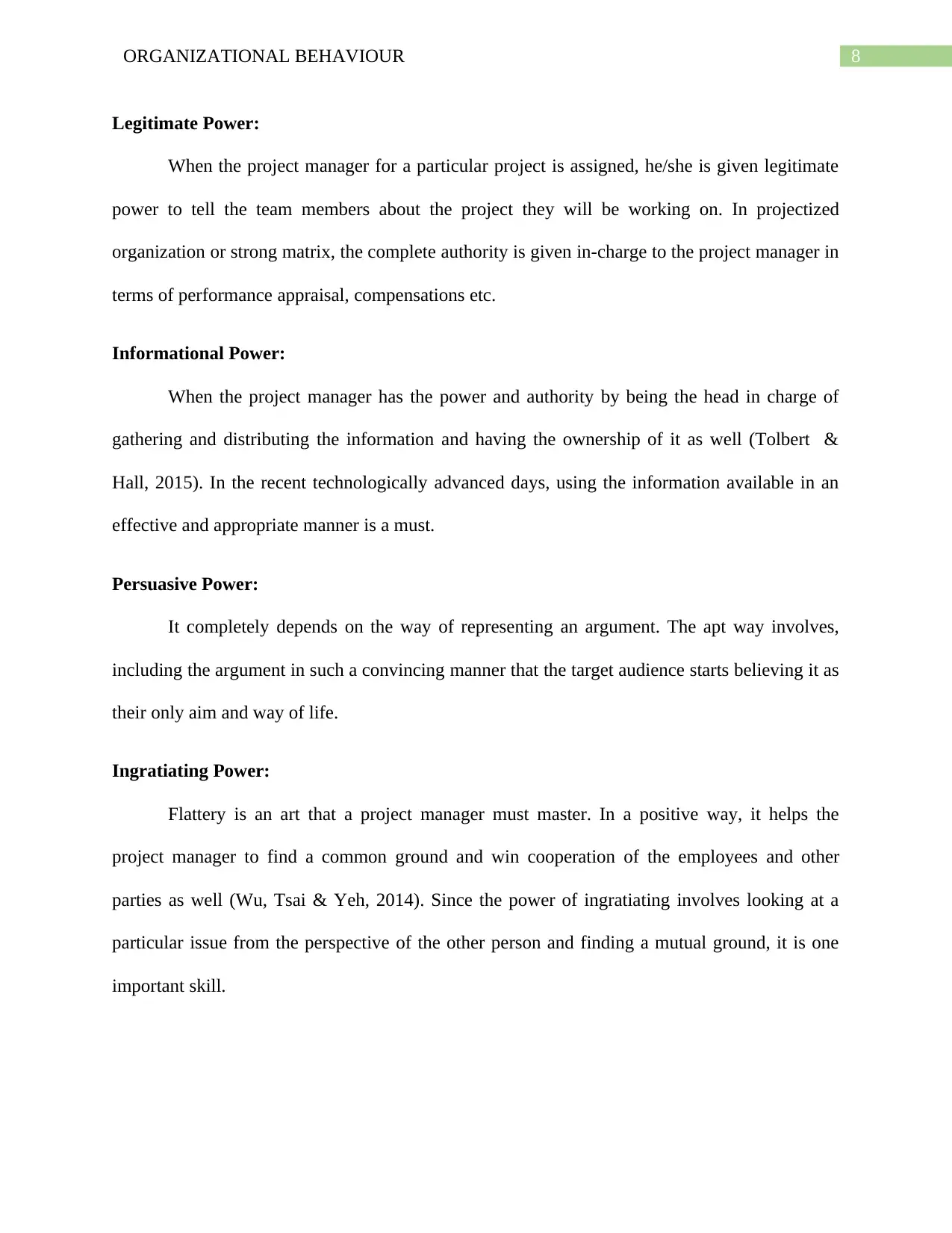
8ORGANIZATIONAL BEHAVIOUR
Legitimate Power:
When the project manager for a particular project is assigned, he/she is given legitimate
power to tell the team members about the project they will be working on. In projectized
organization or strong matrix, the complete authority is given in-charge to the project manager in
terms of performance appraisal, compensations etc.
Informational Power:
When the project manager has the power and authority by being the head in charge of
gathering and distributing the information and having the ownership of it as well (Tolbert &
Hall, 2015). In the recent technologically advanced days, using the information available in an
effective and appropriate manner is a must.
Persuasive Power:
It completely depends on the way of representing an argument. The apt way involves,
including the argument in such a convincing manner that the target audience starts believing it as
their only aim and way of life.
Ingratiating Power:
Flattery is an art that a project manager must master. In a positive way, it helps the
project manager to find a common ground and win cooperation of the employees and other
parties as well (Wu, Tsai & Yeh, 2014). Since the power of ingratiating involves looking at a
particular issue from the perspective of the other person and finding a mutual ground, it is one
important skill.
Legitimate Power:
When the project manager for a particular project is assigned, he/she is given legitimate
power to tell the team members about the project they will be working on. In projectized
organization or strong matrix, the complete authority is given in-charge to the project manager in
terms of performance appraisal, compensations etc.
Informational Power:
When the project manager has the power and authority by being the head in charge of
gathering and distributing the information and having the ownership of it as well (Tolbert &
Hall, 2015). In the recent technologically advanced days, using the information available in an
effective and appropriate manner is a must.
Persuasive Power:
It completely depends on the way of representing an argument. The apt way involves,
including the argument in such a convincing manner that the target audience starts believing it as
their only aim and way of life.
Ingratiating Power:
Flattery is an art that a project manager must master. In a positive way, it helps the
project manager to find a common ground and win cooperation of the employees and other
parties as well (Wu, Tsai & Yeh, 2014). Since the power of ingratiating involves looking at a
particular issue from the perspective of the other person and finding a mutual ground, it is one
important skill.
⊘ This is a preview!⊘
Do you want full access?
Subscribe today to unlock all pages.

Trusted by 1+ million students worldwide
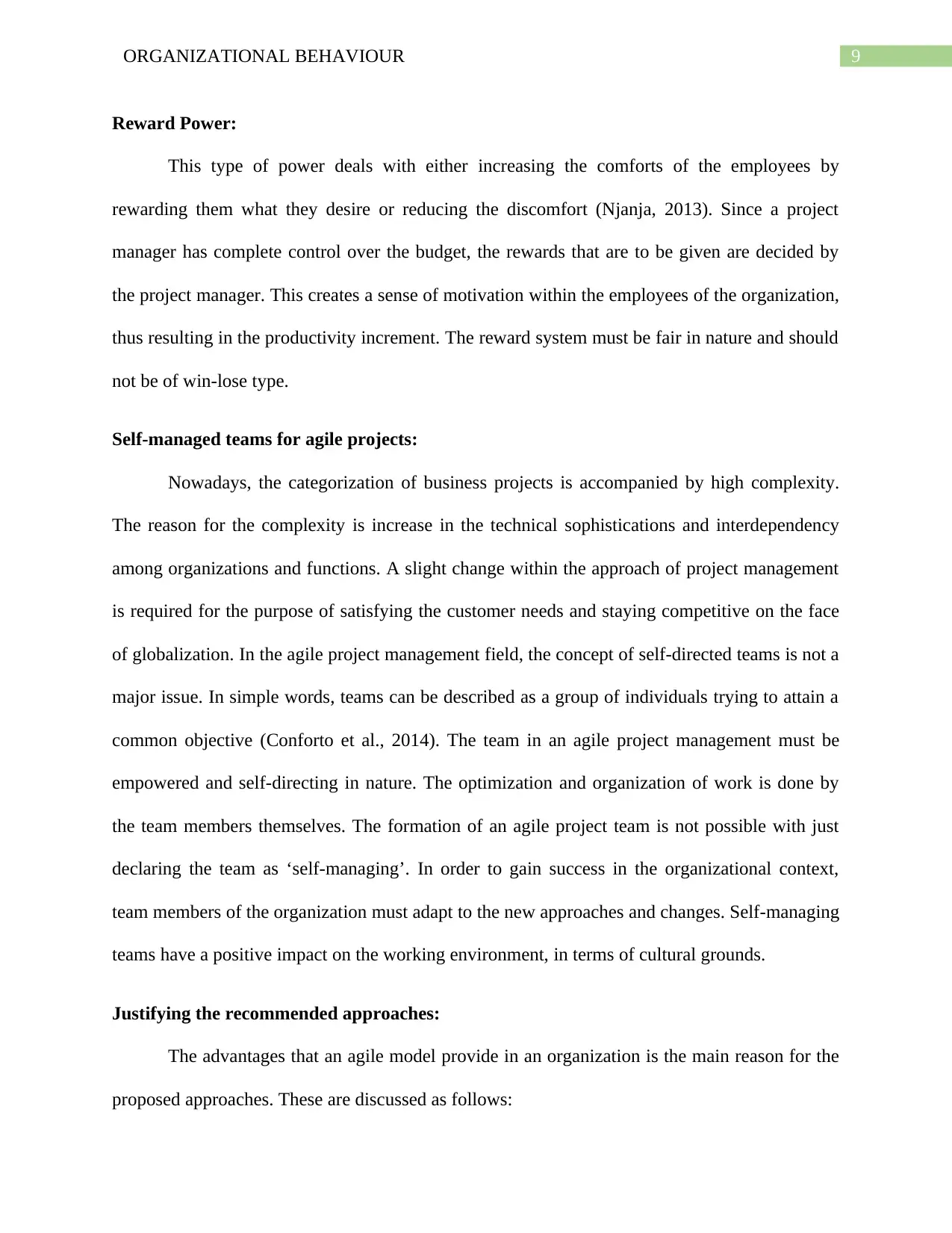
9ORGANIZATIONAL BEHAVIOUR
Reward Power:
This type of power deals with either increasing the comforts of the employees by
rewarding them what they desire or reducing the discomfort (Njanja, 2013). Since a project
manager has complete control over the budget, the rewards that are to be given are decided by
the project manager. This creates a sense of motivation within the employees of the organization,
thus resulting in the productivity increment. The reward system must be fair in nature and should
not be of win-lose type.
Self-managed teams for agile projects:
Nowadays, the categorization of business projects is accompanied by high complexity.
The reason for the complexity is increase in the technical sophistications and interdependency
among organizations and functions. A slight change within the approach of project management
is required for the purpose of satisfying the customer needs and staying competitive on the face
of globalization. In the agile project management field, the concept of self-directed teams is not a
major issue. In simple words, teams can be described as a group of individuals trying to attain a
common objective (Conforto et al., 2014). The team in an agile project management must be
empowered and self-directing in nature. The optimization and organization of work is done by
the team members themselves. The formation of an agile project team is not possible with just
declaring the team as ‘self-managing’. In order to gain success in the organizational context,
team members of the organization must adapt to the new approaches and changes. Self-managing
teams have a positive impact on the working environment, in terms of cultural grounds.
Justifying the recommended approaches:
The advantages that an agile model provide in an organization is the main reason for the
proposed approaches. These are discussed as follows:
Reward Power:
This type of power deals with either increasing the comforts of the employees by
rewarding them what they desire or reducing the discomfort (Njanja, 2013). Since a project
manager has complete control over the budget, the rewards that are to be given are decided by
the project manager. This creates a sense of motivation within the employees of the organization,
thus resulting in the productivity increment. The reward system must be fair in nature and should
not be of win-lose type.
Self-managed teams for agile projects:
Nowadays, the categorization of business projects is accompanied by high complexity.
The reason for the complexity is increase in the technical sophistications and interdependency
among organizations and functions. A slight change within the approach of project management
is required for the purpose of satisfying the customer needs and staying competitive on the face
of globalization. In the agile project management field, the concept of self-directed teams is not a
major issue. In simple words, teams can be described as a group of individuals trying to attain a
common objective (Conforto et al., 2014). The team in an agile project management must be
empowered and self-directing in nature. The optimization and organization of work is done by
the team members themselves. The formation of an agile project team is not possible with just
declaring the team as ‘self-managing’. In order to gain success in the organizational context,
team members of the organization must adapt to the new approaches and changes. Self-managing
teams have a positive impact on the working environment, in terms of cultural grounds.
Justifying the recommended approaches:
The advantages that an agile model provide in an organization is the main reason for the
proposed approaches. These are discussed as follows:
Paraphrase This Document
Need a fresh take? Get an instant paraphrase of this document with our AI Paraphraser
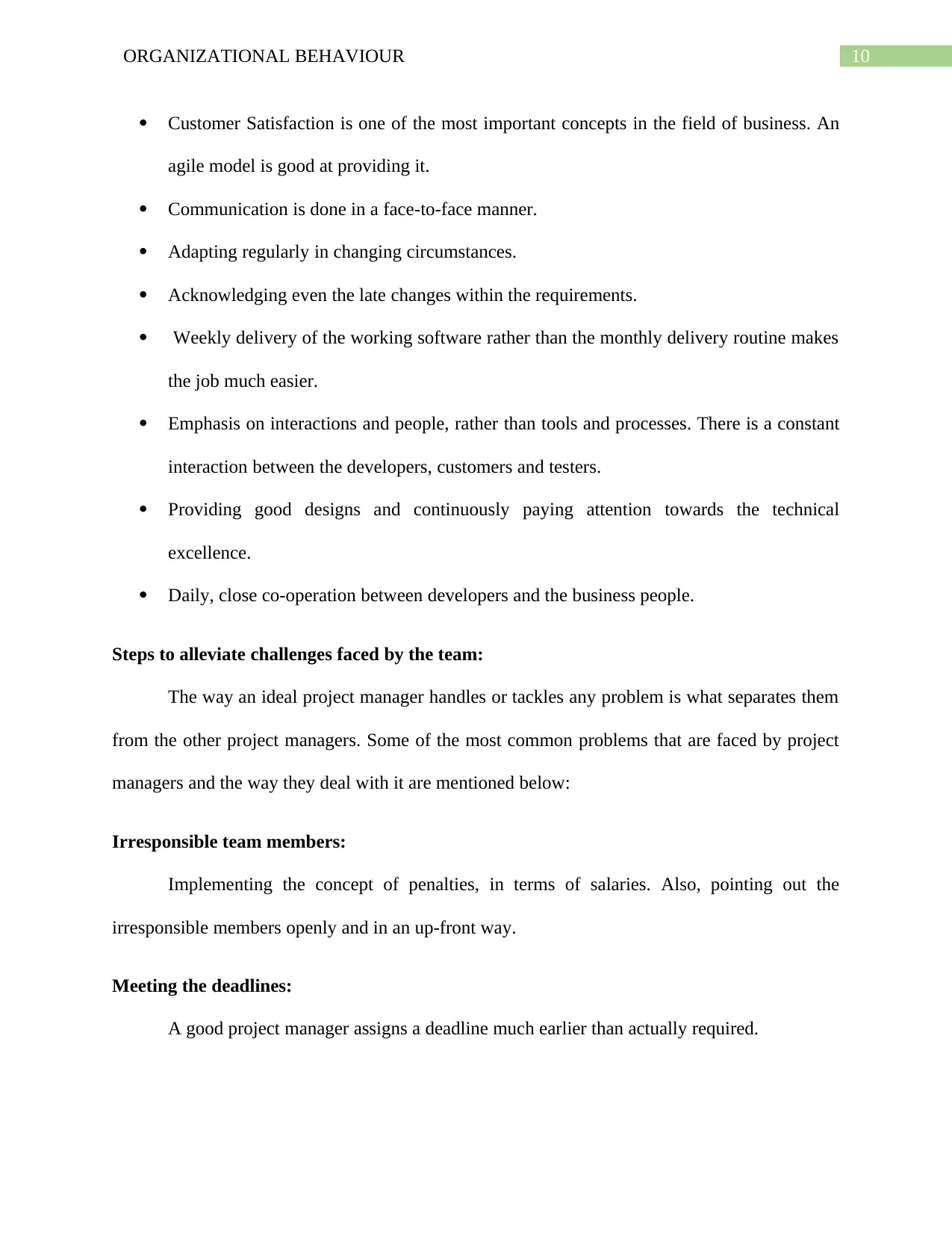
10ORGANIZATIONAL BEHAVIOUR
Customer Satisfaction is one of the most important concepts in the field of business. An
agile model is good at providing it.
Communication is done in a face-to-face manner.
Adapting regularly in changing circumstances.
Acknowledging even the late changes within the requirements.
Weekly delivery of the working software rather than the monthly delivery routine makes
the job much easier.
Emphasis on interactions and people, rather than tools and processes. There is a constant
interaction between the developers, customers and testers.
Providing good designs and continuously paying attention towards the technical
excellence.
Daily, close co-operation between developers and the business people.
Steps to alleviate challenges faced by the team:
The way an ideal project manager handles or tackles any problem is what separates them
from the other project managers. Some of the most common problems that are faced by project
managers and the way they deal with it are mentioned below:
Irresponsible team members:
Implementing the concept of penalties, in terms of salaries. Also, pointing out the
irresponsible members openly and in an up-front way.
Meeting the deadlines:
A good project manager assigns a deadline much earlier than actually required.
Customer Satisfaction is one of the most important concepts in the field of business. An
agile model is good at providing it.
Communication is done in a face-to-face manner.
Adapting regularly in changing circumstances.
Acknowledging even the late changes within the requirements.
Weekly delivery of the working software rather than the monthly delivery routine makes
the job much easier.
Emphasis on interactions and people, rather than tools and processes. There is a constant
interaction between the developers, customers and testers.
Providing good designs and continuously paying attention towards the technical
excellence.
Daily, close co-operation between developers and the business people.
Steps to alleviate challenges faced by the team:
The way an ideal project manager handles or tackles any problem is what separates them
from the other project managers. Some of the most common problems that are faced by project
managers and the way they deal with it are mentioned below:
Irresponsible team members:
Implementing the concept of penalties, in terms of salaries. Also, pointing out the
irresponsible members openly and in an up-front way.
Meeting the deadlines:
A good project manager assigns a deadline much earlier than actually required.
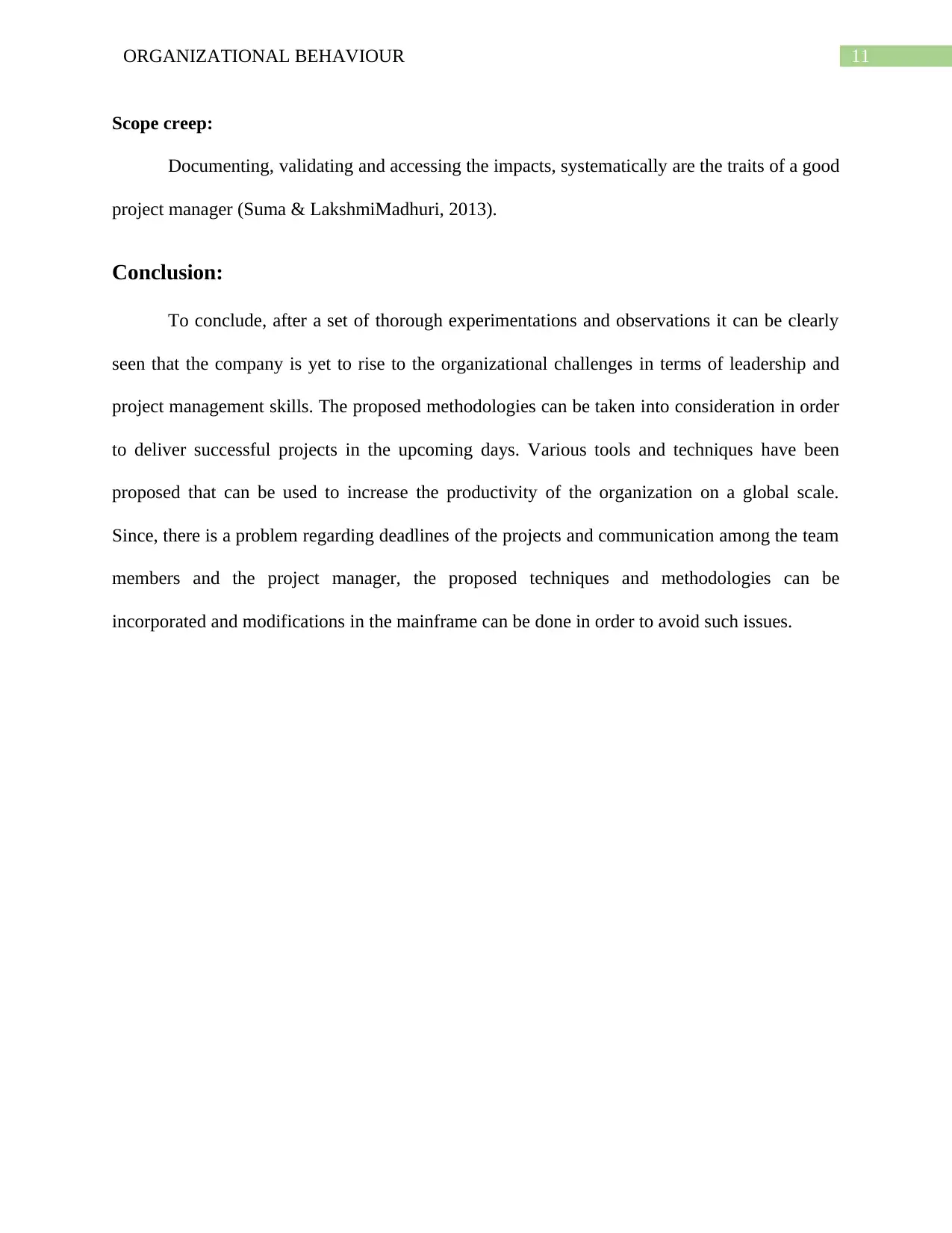
11ORGANIZATIONAL BEHAVIOUR
Scope creep:
Documenting, validating and accessing the impacts, systematically are the traits of a good
project manager (Suma & LakshmiMadhuri, 2013).
Conclusion:
To conclude, after a set of thorough experimentations and observations it can be clearly
seen that the company is yet to rise to the organizational challenges in terms of leadership and
project management skills. The proposed methodologies can be taken into consideration in order
to deliver successful projects in the upcoming days. Various tools and techniques have been
proposed that can be used to increase the productivity of the organization on a global scale.
Since, there is a problem regarding deadlines of the projects and communication among the team
members and the project manager, the proposed techniques and methodologies can be
incorporated and modifications in the mainframe can be done in order to avoid such issues.
Scope creep:
Documenting, validating and accessing the impacts, systematically are the traits of a good
project manager (Suma & LakshmiMadhuri, 2013).
Conclusion:
To conclude, after a set of thorough experimentations and observations it can be clearly
seen that the company is yet to rise to the organizational challenges in terms of leadership and
project management skills. The proposed methodologies can be taken into consideration in order
to deliver successful projects in the upcoming days. Various tools and techniques have been
proposed that can be used to increase the productivity of the organization on a global scale.
Since, there is a problem regarding deadlines of the projects and communication among the team
members and the project manager, the proposed techniques and methodologies can be
incorporated and modifications in the mainframe can be done in order to avoid such issues.
⊘ This is a preview!⊘
Do you want full access?
Subscribe today to unlock all pages.

Trusted by 1+ million students worldwide
1 out of 14
Related Documents
Your All-in-One AI-Powered Toolkit for Academic Success.
+13062052269
info@desklib.com
Available 24*7 on WhatsApp / Email
![[object Object]](/_next/static/media/star-bottom.7253800d.svg)
Unlock your academic potential
Copyright © 2020–2025 A2Z Services. All Rights Reserved. Developed and managed by ZUCOL.





